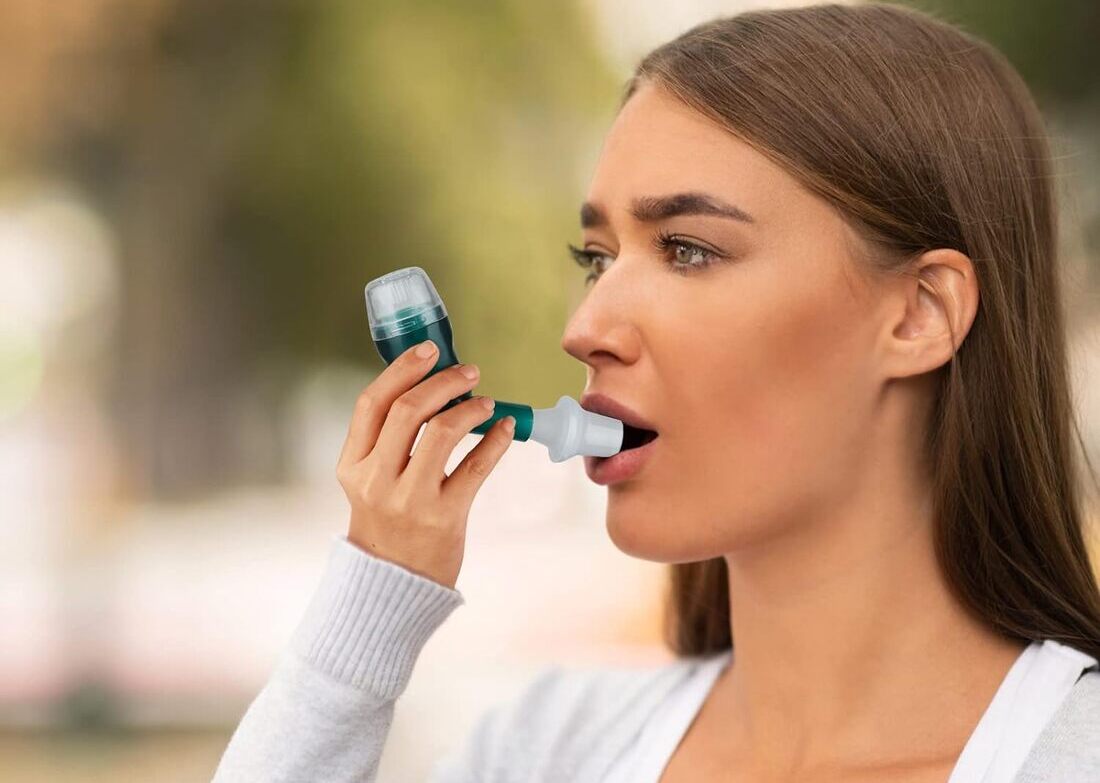Have you ever felt breathless after climbing a few stairs, or struggled to catch your breath during a workout?
Millions of people worldwide experience respiratory limitations that affect their daily lives.

But the good news is, you can improve your lung health and overall well-being with the help of breathing exercises and, in some cases, breathing exerciser trainers.
This comprehensive guide dives deep into the world of breathing, exploring its impact on your health and how you can harness its power for a more fulfilling life.
We’ll discuss:
- The benefits of proper breathing for your physical and mental health
- Different types of breathing exercises and their applications
- How breathing exerciser trainers can further enhance your respiratory health
- Additional lung health tips for optimal respiratory function
Why Breathing Matters: The Foundation of Your Wellbeing
Breathing is more than just a reflex; it’s the cornerstone of good health.
Every cell in your body relies on a steady supply of oxygen delivered through your breath.
When you breathe deeply and efficiently, you:
- Increase oxygen intake: This fuels your metabolism, boosts energy levels, and enhances cognitive function.
- Improve circulation: Deep breathing promotes better blood flow throughout your body, delivering essential nutrients to organs and tissues.
- Reduce stress and anxiety: Controlled breathing activates the parasympathetic nervous system, promoting relaxation and lowering stress hormones.
- Strengthen your immune system: Proper breathing helps remove toxins from the body, creating a less hospitable environment for pathogens.
- Improve sleep quality: Deep, diaphragmatic breathing calms the mind and body, promoting restful sleep.
- Enhance athletic performance: Efficient breathing allows your muscles to utilize oxygen more effectively, leading to improved endurance and performance.
Unlocking Your Inner Calm: A Journey Through Breathing Exercises
Breathing exercises are simple yet powerful tools for optimizing your respiratory health and well-being.
Here are a few popular techniques to get you started:
- Diaphragmatic Breathing (Belly Breathing): This is the most natural and efficient way to breathe. Place one hand on your chest and the other on your stomach. As you inhale, feel your stomach expand, not your chest. Exhale slowly through pursed lips, allowing your stomach to sink back down.
- 4-7-8 Breathing: This calming technique promotes relaxation and focus. Inhale deeply through your nose for a count of 4, hold your breath for 7 seconds, and exhale slowly through your mouth for a count of 8. Repeat this cycle for several minutes.
- Alternate Nostril Breathing (Nadi Shodhana): This technique helps balance the nervous system and improve emotional regulation. Close your right nostril with your thumb and inhale deeply through your left nostril. Close your left nostril with your ring finger and exhale through your right nostril. Inhale through your right nostril, close it, and exhale through your left nostril. Repeat this cycle for several minutes, alternating nostrils each time.
Here is a comparison breathing technique in a tbale format.
Breathing Exercises Table
| Breathing Exercise | Description | Benefits |
|---|---|---|
| Diaphragmatic Breathing (Belly Breathing) | Inhale through your nose, feeling your belly expand. Exhale slowly through pursed lips. | Reduces stress, improves sleep, strengthens respiratory muscles. |
| 4-7-8 Breathing | Inhale for 4 seconds, hold for 7 seconds, exhale for 8 seconds. | Promotes relaxation, improves focus, lowers blood pressure. |
| Alternate Nostril Breathing (Nadi Shodhana) | Close one nostril, inhale through the other. Close the inhaling nostril, exhale through the other. Repeat, alternating nostrils. | Balances the nervous system, improves emotional regulation, reduces anxiety. |
| Pursed-Lip Breathing | Inhale slowly through your nose, exhale slowly through pursed lips. | Eases shortness of breath, helps manage COPD symptoms, slows respiratory rate. |
| Lion’s Breath | Inhale deeply, open your mouth wide and exhale forcefully with a “ha” sound. | Releases tension, energizes the body, improves lung function (consult doctor before using with any medical conditions). |
Breathing Exerciser Trainers: Tools to Enhance Your Respiratory Journey

Breathing exerciser trainers are specialized devices designed to strengthen your respiratory muscles and improve lung capacity.
These devices work by providing resistance or creating a specific breathing pattern.
While breathing exercises alone can significantly improve your lung health, breathing exerciser trainers can be beneficial for:
- Individuals recovering from respiratory illnesses or surgeries: These devices can help retrain and strengthen weakened respiratory muscles.
- Athletes seeking to optimize performance: Breathing trainers can improve lung capacity and enhance oxygen intake during exercise.
- People with chronic respiratory conditions (consult your doctor first): Breathing trainers may be used as a complementary therapy alongside medication to manage conditions like asthma or COPD.
It’s important to note that breathing exerciser trainers are not a one-size-fits-all solution. Before using one, consult with your doctor to ensure it’s appropriate for your specific needs and health condition.
Optimizing Your Respiratory Health: Beyond Breathing
While breathing exercises and trainers play a crucial role in lung health, a holistic approach is essential.
Here are some additional tips to keep your lungs strong and healthy:
- Maintain a healthy lifestyle: Eat a balanced diet rich in fruits, vegetables, and whole grains. Get regular exercise, and avoid smoking and secondhand smoke exposure.
- Manage stress effectively: Chronic stress can negatively impact your respiratory system. Practice relaxation techniques like meditation or yoga.
- Monitor air quality: Pay attention to air quality alerts and reduce exposure to pollutants when necessary. Consider using an air purifier indoors.
- Schedule regular checkups: Get screened for lung diseases like asthma and COPD.
Conclusion: Breathe Easy and Live Full

By incorporating breathing exercises, considering breathing exerciser trainers when appropriate, and adopting healthy lifestyle habits, you can significantly improve your lung health and overall well-being.
Here’s how you can get started on your journey to healthier breathing:
Taking Action: A Guide to Getting Started
- Identify your goals: Are you looking to manage stress, improve sleep, enhance athletic performance, or recover from a respiratory illness? Knowing your goals will help you choose the most appropriate breathing exercises and determine if a breathing exerciser trainer might be beneficial.
- Find a quiet space: Create a comfortable and distraction-free environment for your breathing exercises.
- Start slow and be consistent: Begin with short practice sessions and gradually increase the duration as you become comfortable. Aim for at least 10-15 minutes of daily practice for optimal benefits.
- Seek guidance: There are numerous online resources, instructional videos, and apps that can guide you through different breathing exercises. Consider attending a breathing workshop or yoga class for personalized instruction.
- Listen to your body: Pay attention to how your body feels during and after your breathing exercises. If you experience any discomfort, stop and consult a healthcare professional.
Building a Sustainable Breathing Routine:
- Integrate breathing exercises into your daily routine: Practice them first thing in the morning, before bed, or during breaks throughout the day.
- Combine breathing exercises with other healthy habits: Pair your breathing practice with meditation, yoga, or light exercise for a well-rounded approach to wellness.
- Track your progress: Monitor how your breathing exercises impact your energy levels, sleep quality, and overall well-being. Keeping a journal can help you stay motivated and celebrate your progress.
Remember, consistency is key! By making breathing exercises a regular part of your life, you can unlock the full potential of your lungs and experience a healthier, happier you.
Ready to embark on your journey to better breathing? Explore our sub-category articles for a deeper dive into specific breathing techniques, lung health tips, and natural remedies. We also offer informative guides on various breathing exerciser trainers to help you decide if one is right for you.
Let’s breathe our way to a healthier and more fulfilling life!
Citations
For the Benefits of Proper Breathing Section:
- Improved Oxygen Intake and Cellular Function: You can cite a scientific review like this one: Lundberg JO, Weitzberg E. “Physiology of oxygen: relevance to systemic diseases.” Physiol Rev. 2008 Jan;88(1):481-544. doi: 10.1152/physrev.00046.2007 PubMed
- Improved Circulation: Cite a source like the American Heart Association which highlights the connection between deep breathing and blood flow: https://www.heart.org/en/news/2023/07/07/its-not-just-inspiration-careful-breathing-can-help-your-health
- Reduced Stress and Anxiety: There’s a wealth of research on this topic. You can cite a meta-analysis like this one: Gerritsen RJ, Knipschild G. “Stress management training based on deep diaphragmatic breathing for adults with stress disorders: a systematic review.” J Behav Ther Exp Psychiatry. 2017 Dec;59:1-11. doi: 10.1016/j.jbtep.2017.09.003. Epub 2017 Sep 12. PubMed
Disclaimer: The information in this article is for educational purposes only and does not constitute medical advice. Always consult with your doctor before starting any new breathing exercises or using a breathing exerciser trainer, especially if you have any underlying health conditions.
Related Posts


